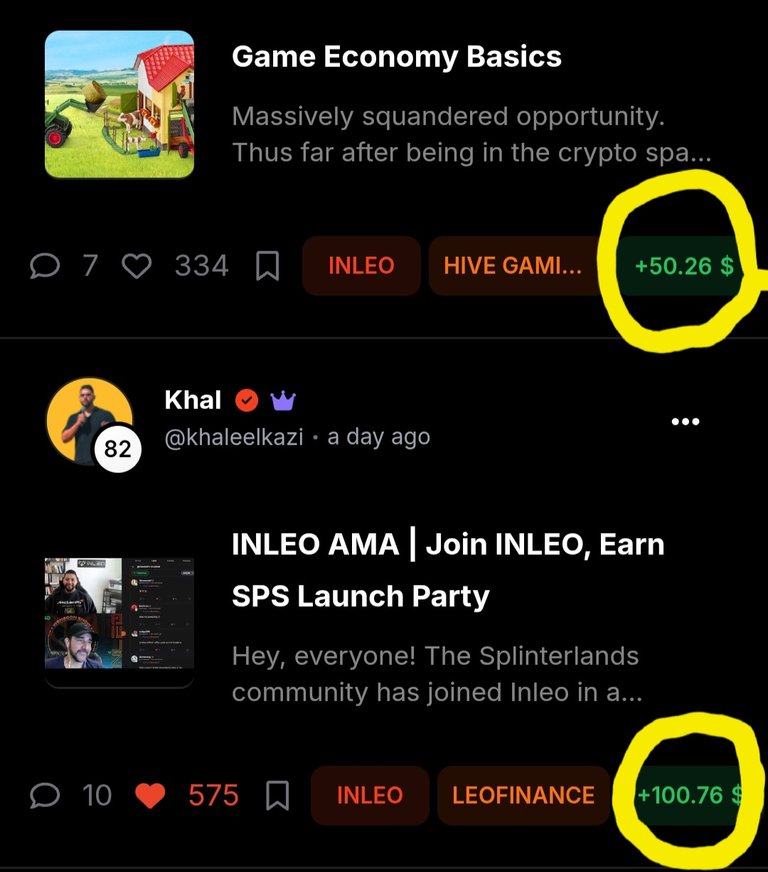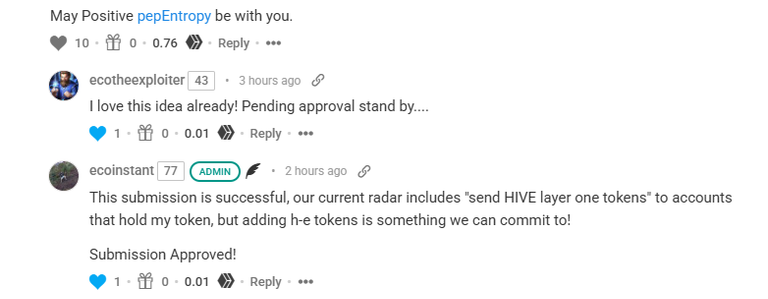If you want to join the LeoStrategy mission to acquire LEO and generate accretive yield for our shareholders, go to your favorite Hive-Engine interface and buy 1 share of LSTR
Just 1 share gets you a seat at the table. Let's make $LEO a $250M ecosystem
Pretty sure every time Bitcoin took/takes a bath there's another press release from Michael Saylor telling everyone how much more he bought and at what price. He's been right every time. Now seems like a pretty good time for LSTR to do the same...
so this is basically Michael Saylor move on Blockchain then let me get my wallet, how to even use the engine, I think I just got family with keychain can I just swap something for that share?
I recently understand how exercise benefits our body when I was having a back pain. I was advised to start an exercise routine every morning, and guess what? The paid stopped just after the first day exercise period.
I do this with all the x livestream summaries, but I need to run it on my own hardware so cannot automate it. Doing it by API is not economically viable
Yes, I've seen that the "X" API's use has skyrocketed in price. Maybe Odysee's and Rumble's are still economically accessible. Or your service could be financially supported by INLEO, as part of the platform's native features.
It's not accessing the various services that is expensive. It the actual transcription of the audio, i.e. running the voice to text software.
If I run it on my own hardware, 2 hours of taking takes about 20 minutes with my RTX4090 (high-end, consumer grade graphics card). This is how I currently transcribe x spaces - I fetch the link from the site, download it to my computer, run the transcription software (Whisper AI) on the file and then I do a summarization of the transcript using one of the AI model providers (currently Anthropics Claude)
If I were to do the transcription via a text to audio API (like openai), it would get very expensive very quickly. So in other words, if there is no transcript, no summary. This is why I've suggested incentivized video transcription on spknetwork, so that people can volunteer their own hardware to transcribe videos. I've promised them that the moment there are transcripts on 3speak, I'll make the ai summarizer work for 3speak videos as well.
specifically, this one is a $10 billion Meta AI project in Louisiana. there's literally nothing where it's being built. no stores, no infrastructure. just farmland.
Yea InLEO already provides the 4 of the 5 major content formats. Livestream is the only one missing so im looking forward to it. This a graphic from a short I'm posting shortly. Cant think of another platform that has all these options
I made a threadcast giveaway about this yesterday, asking people to guess the genre we will release today.
And sadly no one guessed right. 😱
So sorry! But there will be more opportunities for winning some Hive!
The genre I was looking for was MINIMAL TECHNO! 🎵
3Speak has issues again and I can´t upload the snippet to our new release. It is currently stuck in the opload queue.. Will show that as soon as possible.
But you can find all links to major platforms in replies to this thread!
Yeah for sure! We don´t use TikTok though. It´s so much work to be present at all the social media platforms. And our music is going great and the listeners are growing without much promotion, so we didn´t start with TikTok.
Thanks nice offer. I just don´t have any more time to put into anything. Sure would be cool to have someone build up my own account for me. But depends on what the costs are.
I was a bit worried about one of team members... I wasn't sure she was mature enough to move up to the next level but she just delivered an amazing data analysis. So proud of her!
I see in the news that President Trump's administration is wasting no time in rounding up criminal illegal immigrants for deportation. Their home countries should be prepared to receive these criminals, meaning that citizens should beware these violent people. These are a different type than the ordinary illegal immigrant who is merely looking for better economic conditions.
This is where he is starting. Once they are deported the focus will shift to ordinary illegal immigrants. However, there are reports of many who are self-deporting rather than wait to be found.
Let's put doters in to office - so we can free for all and blame'emYeah problem with those reports is, you need a salt mine. I've no real clue, but #hoover hadn't use the most legal #methods.
I had to basically live off some of the powerdowns I got over the past few years. only way i kept my family above water but that's dried up now. so while i still sent a chunk of it to LEO, I did cash some out to buy food lol
yes absolutely, been a great week, it's weekend now, trying to get more active on this platform because I've now seen that engaging is pretty fun. So much to look at here
If you own 10 or more BBH tokens you got a drip of swap.hive.
If you own 5,000 or more BBH tokens you got a drip of swap.hive and the PIMP token, and CTP Tokens and SLOTHBUZZ.
If you own 10,000 or more BBH tokens you got a drip of swap.hive, PIMP, CTP, SLOTHBUZZ. and LEO tokens.
I suspect that files, once released, will not contain anything particularly shocking or groundbreaking. I think that Trump's failure to release files in his first term had less to do with the actual content and more with Pompeo and Deep State trying to show who had the last word.
or like the Pentagon on 911, a “plane” will hit the side of the building where the records are kept. Then they won’t find any evidence of a plane… in the Pentagon’s case, it was the accounting offices a day after announcing they LOST over 2 trillion dollars…
A friend who is former Fire Chief would say it was mysterious that warehouse fires seemed to occur after bad produce seasons. I'm sure the feds have mysterious fires all the time.
Using XMrig as the mining software. You can mine either Monero, or Wownero which is the meme fork of Monero. There are some other smaller coins that you can still CPU mine as well, but I don't mess with them. I am an $XMR kinda guy.
Budget. Got this one for $325 on ebay. Was intending to buy the first version 1 of the miner I currently have, but found out that eBay will not let you pay for a 'virtual currency' miner with a gift card. So I said jokes on you, I can mine monero with a regular computer, lol. I went with the Mac mini M2 over a mini pc with a light weight ryzen chip is that it get better CPU power on way less power. Only takes up like 30W max. Perfect for my solar rig. Also, Macs hold their resell values extremely well, so if it doesn't work out for mining, then I have a Mac I can resell for probably more than I bought it for.
EDIT: Or I can use it for a drone flight simulator and a full monero node, lol.
If you stake 20,000 or more BBHO tokens you get a drip of swap.btc, BRO, and DUO tokens
If you stake 5,000 or more BBHO tokens you got a drip of BRO and DUO tokens.
If you stake 2,000 or more BBHO tokens you get a drip of DUO tokens.
Don't want to sound too pessimistic but I've noticed that it's very hard to shake off the FUD stains in crypto. Even after the system is fixed. Then again, maybe this isn't the best beek to make assumptions cos everything else is down as well
I quickly asked an AI to summarize the situation and got this:
The recent plummet in the price of THORChain’s RUNE token is primarily driven by speculation about the platform’s financial instability, as rumors of insolvency have spread widely. Additionally, THORChain has paused its services for 90 days to address technical issues, further eroding investor confidence. Market dynamics, including bearish sentiment and a negative funding rate, have also contributed to the decline. These factors have created significant selling pressure, leading to sharp price drops.
It feels great when you are able to pay off all your outstanding bills without breaking your bank account. I feel bullish for the weekend, gonna party hard.
Tonight, I will be onboarding my first son to inleo. He's very much into books and writing, and I hope he should be able to share some of his thoughts and writing here.
Good luck! I tried to get both my Gen Z kids to join up. Even created their accounts and bought them a bunch of Splinterlands packs... Neither of them were interested, lol. Now I have all the cards in my account, lol.
#gmfrens! Here is the Motivation, Inspiration Success #threadcast for 1/24/2025
#1440minutes #motivationsonleo #inspirationonleo #successonleo #motivation #inspiration #success
!summarize #cheatcode #success
https://inleo.io/threads/view/pouchon/re-leothreads-vhb1wrz2?referral=pouchon
Legacy Builders -- 5 Habits to Change Your Life in 30 Days | TONY ROBBINS MOTIVATIONAL SPEECH
!summarize
Mel Robbins -- How to Achieve Any Goal You Have in 6 Simple Steps
!suammarize
Clark Kegley -- 7 One-Minute Habits That Save Me 20+ Hours a Week
!summarize
Unlocking Life -- The Four Seasons of Personal Growth | Jimrohn's lesson
!summarize
LITTLE BIT BETTER -- Forget Discipline - Here’s a Smarter & Easier Way To Get Things Done
!summarize
AI for PI -- Unlock Your Inner Power: 9 Simple Habits for Unshakable Discipline
!summarize
!summarize #success #wise #smarts #silence
!summarize #success #focus
!sumamrize #nassimtaleb #cognative #biases #success
!summarize #money #success #focus #obsession
!summarize #discipline #success #motivation #willpower
!summarize #carljung #darkside #success #purpose #life
About to stockpile $LEO like nobody has ever seen
If you want to join the LeoStrategy mission to acquire LEO and generate accretive yield for our shareholders, go to your favorite Hive-Engine interface and buy 1 share of LSTR
Just 1 share gets you a seat at the table. Let's make $LEO a $250M ecosystem
Pretty sure every time Bitcoin took/takes a bath there's another press release from Michael Saylor telling everyone how much more he bought and at what price. He's been right every time. Now seems like a pretty good time for LSTR to do the same...
so this is basically Michael Saylor move on Blockchain then let me get my wallet, how to even use the engine, I think I just got family with keychain can I just swap something for that share?
what’s the plans to acquire more?
Probably involves pressing the buy button haha I want to do the same before the end of next week
what a time to be alive!!
About to do some more $LEO stockpiling as well. These prices won't last long!
Will need to double in price before I take a pause though--unless I run out of cash. 😀
Wait until I get mine first ahahah
please I use the keychain app to get the LsTr
We have Micheal Saylor here?
wen? Soon?
Still the best name for a podcast was when khal called his ama the wensoon show.
I can use this quote to build my stock pile of #leo. Why not reach 200k this year !
I guess the right time to focus on that goal is now with Leo at a discount price.
this is deep and true. The moment we lose focus on it, all we see is reasons why we can't do it. You're a man on a mission and it'll be completed
weel said
Thinking about buying some new work clothes.
so many eyes, I believe you can see me RN😎
this is lit I like your fashion sense man, as the kids say, it's fire.
Heading out to work for the day.
Income has been slow lately due to Snow storms.
Adding a few minutes of exercise to your day can add years to your life.
#health #sleep
I recently understand how exercise benefits our body when I was having a back pain. I was advised to start an exercise routine every morning, and guess what? The paid stopped just after the first day exercise period.
I am open to exercising but now I see how powerful it is when you know you need it.
on1
shure, pal
Purchased a plot for less than 10$. Still need 3 more plots to get a warden prefix title that will give 5% bonus on my battle rewards.
#splinterlands #spt
You rock too
once rocks like these sold for 100s of thousands of dollars. Lmao
Let's rock together
Good morning Lions!

#gm #Inleo #hive
GM
Good Morning :)
Wishing you a great day!
good morning
morning
good morning
Time to feed LeoAI some more!
We need to grow our database.
If you have access to @mightpossibly summarize tool, feel free to jump in!
#threadcast #leoai #cent
how to get the summarise tool by @mightypossibility?
Subscribe to @mightpossibly creator subscription :)
!summarize #dash
!summarize #working #retail
!summarize #passive #youtube
!summarize #inleo
!summarize #tierlist
!summarize #tech #usa #europe #trump
!summarize #youtube #income
!summarize #omniman
!summarize
!summarize
!summarize #russia #ukraine #war
!summarize #tooth #brushing
!summarize #2024
!summarize #wealth #secrets
!summarize
!summarize #investing #portfolio #dividend
!summarize #ultra #running
!summarize
!summarize #crypto
!summarize
!summarize
!summarize #youtube #editor
!summarize
!summarize
!summarize
!summarize #ecommerce
!summarize #tesla
!summarize #faceless #youtube
!summarize #israel #palestine
!summarize #russia #economy
!summarize
!summarize
!summarize #starting #business
!summarize #laid #off #older
!summarize #leaving #uk
!summarize
!summarize #greenland #trump
!summarize #food #pcos
!summarize #net #worth
!summarize #youtube
!summarize #nvidia
!summarize
!summarize #superspeed
!summarize #ai
!summarize #memecoin #crypto
!summarize #football #youtube
!summarize
!summarize
!summarize #iron #harvest
!summarize #memecoin #trading
!summarize #content #creator
!summarize
!summarize
!summarize
!summarize
!summarize
!summarize
!summarize
!summarize
!summarize
!summarize
!summarize
!summarize
!summarize
!summarize
!summarize
!summarize
!summarize
!summarize #uk #tree #planting
!summarize #tech #oligarchs
!summarize #altcoins #predictions
!summarize
!summarize
!summarize
!summarize #russia #ukraine #war
!summarize
!summarize
!summarize #russia #putin #economy
!summarize #monero
https://www.youtube.com/live/jxPulIjhXwg?si=7Sv0bKVWorD8Y3gC !summarize #monero
!summarize #monero
!summarize #maya #cacao
!summarize #maya #protocol
!summarize #defi #maya #protocol
!summarize #maya #protocol
!summarize #maya #protocol
!summarize #maya #protocol
!summarize
!summarize #flipchain
!summarize
!summarize
!summarize
!summarize #policy #war
!summarize
!summarize #policy
!summarize
!summarize
!summarize
!summarize
!summarize
!summarize
Here is the #threadcast for today's episode of The Lion's Den. It will start at 1 PM eastern time.
In this episode we will discuss:
Drop any questions or comments.
be careful Task those AI robot chemical factories that blow up may start the robot revolution
I agree with Nifty. AI factories are just now being built.
This will be the largest change in tech since the internet.
Crypto needs to stop thinking like it is 2017
yep, rural land is going to become extremely valuable. it's already happening in the area i mentioned.
everyone will have their own personal language model they carry with them in the future. Talking to it will be how you interact with the world
TikTok algorithm is sometimes funny and confusing.
I do this with all the x livestream summaries, but I need to run it on my own hardware so cannot automate it. Doing it by API is not economically viable
https://inleo.io/threads/view/ijatz/re-taskmaster4450-gnc5xpu3?referral=ijatz
Yes, I've seen that the "X" API's use has skyrocketed in price. Maybe Odysee's and Rumble's are still economically accessible. Or your service could be financially supported by INLEO, as part of the platform's native features.
It's not accessing the various services that is expensive. It the actual transcription of the audio, i.e. running the voice to text software.
If I run it on my own hardware, 2 hours of taking takes about 20 minutes with my RTX4090 (high-end, consumer grade graphics card). This is how I currently transcribe x spaces - I fetch the link from the site, download it to my computer, run the transcription software (Whisper AI) on the file and then I do a summarization of the transcript using one of the AI model providers (currently Anthropics Claude)
If I were to do the transcription via a text to audio API (like openai), it would get very expensive very quickly. So in other words, if there is no transcript, no summary. This is why I've suggested incentivized video transcription on spknetwork, so that people can volunteer their own hardware to transcribe videos. I've promised them that the moment there are transcripts on 3speak, I'll make the ai summarizer work for 3speak videos as well.
@mightpossibly Have you researched the sound to text models, to offer them in your service?
specifically, this one is a $10 billion Meta AI project in Louisiana. there's literally nothing where it's being built. no stores, no infrastructure. just farmland.
https://aibusiness.com/generative-ai/meta-to-open-10b-ai-data-center-in-louisiana
until it gets snowed in.
hahaha they wont know what the hell to do
I work within the Salesforce echosystem (not for Salesforce) and I can confirm. They are pushing AI like crazy on every aspect
I believe SPS = SPlinter Shards
I think that is correct
https://inleo.io/threads/view/simplegame/re-leothreads-31xggyzhd?referral=simplegame
Yea InLEO already provides the 4 of the 5 major content formats. Livestream is the only one missing so im looking forward to it. This a graphic from a short I'm posting shortly. Cant think of another platform that has all these options

Hopefully the SPS theme will open broader horizons for InLeo and Splinterlands
I am not sure it opens up much more than simply within Hive. Heck, my guess is that we are dealing with those who are on Leo already.
Yeah, we can stop using X Space when the Live stream on INLEO is launched.
Ciao
I havent played Splinterlands in a while but I like the integration
Me neither.
I think a lot went that route.
Good afternoon friends, greetings to all present.
Good day. Glad you made it. We are live.
Thank you, I'm joining now.
You could already have a live stream here in the threadcast via youtube though … including recordng …
To be honest, sometimes I get amused finding what TikTok algorhitms think I like. I'm certain that I will similar kind of amusement with AI.
bye
The AMA is doing it for some time now already …
yea creating content doesnt help if u cant repurpose it. Waste of data capital
Task, what are acoording to you the reasons why VIMM hasn't really taken off inside the Hiver/INLEO Community?
It has (or had) the potential of Twitch, or more.
Yeah and rightly source them.
The more features you put in, the less people leave the platform. The attention is captured and monetized
That live feature will bring a lot more fun and engagement (in turn users) to the feed
Neither does Odyssey. Nor Twitch
Rumble doesn't transcribe videos. No subtitles, no text data
The answer is yes
https://inleo.io/threads/view/the-african-man/re-taskmaster4450-24hsycduk?referral=the-african-man
Yes. I noticed a lot of familiar faces that claimed that they were leaving X for BlueSky only to return.
Since SPS is a token, can it be used to purchase premium and bring revenue to Inleo?
Yes, it can
https://inleo.io/@alexvan/leo-premium-with-sps-leo-premium-mit-sps-2ff
The tiktok EO was part of the law banning it.
A president can give a 90-day extension.
So in 80 some days we will see what happens.
And as soon as TikTok ban was suspended, RedNote romance was over.
Whats the meaning of SPS?
Splinterlands is a Hive-engine game not a Hive game.
I find amusing that the only social media service to actually benefit from TikTok ban was RedNote.
Yeah, I can hear you now. I had to refresh my page.
as google search loses market share to AI online advertising is crashing also.
Joining in quick
All awesome topics to be elaborated. Inleo is marching forward in style.
not only this, but to power it, Entergy is building a giant power plant. AI going to trillions
https://inleo.io/threads/view/l337m45732/re-leothreads-2vnrqut7g
#AI #agent companies are gonna take over so much work from all over the #world
Salesforce recently announced their agent solution (Agentforce) and they are focusing most of their attention to it now
Yeah there was #twitter back in the #day^^
Wow, this is my first time attending this, what really do happen here, please am a newbie, I wanna learn.
Click here to join the call on X Space. 👇
https://inleo.io/threads/view/winanda/re-taskmaster4450-fsw43byo?referral=winanda
It is a conversation on several planned topics.
https://inleo.io/threads/view/the-african-man/re-taskmaster4450-2dr1arqhz?referral=the-african-man
Here is the X Space link.
Two coins of great value and importance.
https://inleo.io/threads/view/ben.haase/re-taskmaster4450-2mrxn66m6?referral=ben.haase
They can also get premium with SPS.
$BTC & $ETH are the introduction piece for #crypto & #blockchain
Where will today's talk be?
on X as always
it is showing up on top of the page now
Here we go!
Ready to listen.
Don´t get me wrong, but are these typos in the picture on purpose? :D It´s a bit weird.
ai-generated stuffs
Hi, @mightpossibly,
This post has been voted on by @darkcloaks because you are an active member of the Darkcloaks gaming community.
Get started with Darkcloaks today, and follow us on Inleo for the latest updates.
I know. :D I just didn´t want to say it too obvious. :D Just confusing that someone uses it, although there are so many mistakes. :D
AI will be there
Is Al short for Alfred or Albert?
I will post the link tot he spaces in here soon.
Here is the space...please set a reminder.
We start in 1 hour
https://inleo.io/threads/view/mightpossibly/re-leothreads-2uxm7ifjt
We are over 30 million tokens generated by AI summaries.
We are live.
Is Taskmaster on mute? I can't hear him again.
Thanks Task for today's Lion's Den.
thanks for the show
Thanks for the show.
oh I missed this cast I'll put the time down, it's everyday right?
Every friday 👍
nice looking forward to it
Hi, @mightpossibly,
This post has been voted on by @darkcloaks because you are an active member of the Darkcloaks gaming community.
Get started with Darkcloaks today, and follow us on Inleo for the latest updates.
Here is an episode summary:
https://inleo.io/threads/view/mightpossibly/re-leothreads-ht3bjmyv?referral=mightpossibly
Keep up the good work
I am interested in learning more about the Deepseek and Thinking AI.. Give me a short brief what to expect in Den from this topic?
Excited to see Inleo Ai and these new features
#threadstorm 1/6
New Panda Beats release is out! 🎶🐼
I made a threadcast giveaway about this yesterday, asking people to guess the genre we will release today.
And sadly no one guessed right. 😱
So sorry! But there will be more opportunities for winning some Hive!
The genre I was looking for was MINIMAL TECHNO! 🎵
3Speak has issues again and I can´t upload the snippet to our new release. It is currently stuck in the opload queue.. Will show that as soon as possible.
But you can find all links to major platforms in replies to this thread!
Thanks @tompollandinleo @calebmarvel01 @cpol @ciskodisco.opus @techstyle @tokenizedsociety @jefalen @mayhem9110 @uwelang @herman-german @imfarhad for guessing!
#music #release #pandabeats #raven #techno #minimal #giveaway
Wow!!
Turn will count on someone someday..
yeah! =)
Wow better luck next time,
That an amazing beats out there.
Yeah, I hoped someone would guess it right. :D
But there will be more giveaways.
Thank you! =)
Don't worry I will be the one not someone else. 😀 smiles
Haha alright! =) Next giveaway is coming soon! !PIZZA
Lol hoping to get lucky with that. it's going to be on my circle this time. One love♥️
Cool! Good luck for you! =) I have the idea for the giveaway already. But this will be in a few days.
ouch . will be waiting for the next contest
Yeah. Next contest will come in a few days. Hopefully more luck for someone!
Will have more luck next time hopefully !PIZZA
Hope so too! =)
I believe dropping this beat at TikTok will sound nice too if you have the account, I can even use it to create some content over there.
Yeah for sure! We don´t use TikTok though. It´s so much work to be present at all the social media platforms. And our music is going great and the listeners are growing without much promotion, so we didn´t start with TikTok.
I can help to create your presence there too to support your goals
Thanks nice offer. I just don´t have any more time to put into anything. Sure would be cool to have someone build up my own account for me. But depends on what the costs are.
That's not going to cost you much, I can do that to support your projects
We can talk about that if you want to. Maybe we will find a way of working together. :) Do you have Discord?
I can help and assist you with that.
Thanks for your offer! :)
2/6
YOUTUBE:
#threadstorm #music #minimal #techno #raven
I have checked the YouTube beat right away.
Thanks for checking! =)
3/6
SPOTIFY:
~~~ embed:embed/album/42IyTakfT5GffVM4NwURkY?nd=1&dlsi=4c407653ee754b98 spotify ~~~
#threadstorm #music #minimal #techno #raven
4/6
APPLE MUSIC:
https://music.apple.com/us/album/minimal-techno-odyssey-2/1792029852
#threadstorm #music #minimal #techno #raven
5/6
DEEZER:
https://www.deezer.com/en/album/700678681
#threadstorm #music #minimal #techno #raven
6/6
AMAZON MUSIC:
https://music.amazon.de/albums/B0DTJX9TF8
#threadstorm #music #minimal #techno #raven
I was a bit worried about one of team members... I wasn't sure she was mature enough to move up to the next level but she just delivered an amazing data analysis. So proud of her!
congratulations to this lady, the Young ones can surprise like never expected. Good luck with the projects and work
Lunch is served, the very meal I was craving for. White Rice and tomato sauce stew with soft cow skin, all blended to taste as I like it.
that is an interesting dish! I’ve never heard of cows skin meal, but I’m sure it’s delicious. I hope you enjoyed your lunch.
Yeah, very delicious. Here, cow skin is a special kind of meat. It's prepared separately from the usual cow beaf.
A significant surge is on the horizon.
$HIVE subiendo 🚀
https://inleo.io/threads/view/solymi/re-leothreads-33lyyvjm1
I'm glad I bought a few on my exchange.
Very well played.
Had the massive pleasure of chatting with Joe Parkin about Zypto, one of the bigger sleeper hits of the crypto-as-money world.
Really excited to dive deeper into Zypto, as it could help so many around the world to finish their transition away from fiat entirely.
#crypto #dash
this is an exciting project.
this is on my listen list for later today.
Happy Friday to you too..enjoy your weekend
Yup, weekend is here again.
Great to experience another weekend
and now it's Saturday, doing a little chores then back to watch the charts and then news and see how good I'm getting with crypto
I see in the news that President Trump's administration is wasting no time in rounding up criminal illegal immigrants for deportation. Their home countries should be prepared to receive these criminals, meaning that citizens should beware these violent people. These are a different type than the ordinary illegal immigrant who is merely looking for better economic conditions.
could this be Mr president comeback force to fight against criminal element in the states.
This is where he is starting. Once they are deported the focus will shift to ordinary illegal immigrants. However, there are reports of many who are self-deporting rather than wait to be found.
so do you think it a good idea to make a decision you will later regret,
What would be regretful about deporting criminals?
nothing to actually regret
10 articles lined up for studying and potentially writing posts about... gonna be a busy weekend!
More strength my friend.
oh then let me follow you for all those articles ma boy. Good luck on it. What are the main topics by the way?
Sunset:
 #natureonleo #sunset #photography
#natureonleo #sunset #photography
Beautuful sunset, what camera device did you use to take the photo
A very nice photo.
Really looking forward to see new information on these murders. The government has kept it a secret for far too long.
#news #politics #Trump
biden did it, !LOLZ
Well he's too insane to stand trial, so were f***d there lol
Let's put doters in to office - so we can free for all and blame'emYeah problem with those reports is, you need a salt mine. I've no real clue, but #hoover hadn't use the most legal #methods.
!LOLZ
lolztoken.com
What does alcohol do?
Credit: reddit
$LOLZ on behalf of ben.haase
(2/10)
Delegate Hive Tokens to Farm $LOLZ and earn 110% Rewards. Learn more.@ogrenkondrat, I sent you an
Yes this is interesting!
What’s the biggest financial blunder ever experienced?
Personally, my biggest blunder was going six figures deep into UST based liquidity pools...
ha ha ha ha ha ha getting into crypto
Man being a blogger on Inleo can be nice! 🦁

Have you tried posting longform? 🦁
#cent #leo
Just posted a long form! If i get 10% of those earnings I'd be a happy sloth!
not too shabby!
This is a decent daily income in many countries around the world :) 🦁
A decent monthly income for many countries from one post! Crazy!
If only it goes as seen.
yea lol my rewards dont hit that high but its still very much worth a try #thatwork #socialnetworth
They are very well known users so 🦁
Work week flew by!
Fri-Yay already!
Hope you Lions have an epic end to your work week and.....Buy MOAR $LEO !!!!!
Cheap $LEO 🤩
i ended up buying about 700 last night. hope to grab some more today
Frecking awesome! 🦁
you're somewhat the god of buying crypto. Spot the next Micheal Saylor
Why you think leo is still lingering at 3 cents? I don’t get it..
Million dollar question. I have no idea....Everything that's being built here , doesnt make any sense that it's so cheap
Maybe it is because the dash folks are converting earned leo to dash and not stacking any leo? I don’t know…
yeah it's so weird. with all the tools that are being built, and ways leo is getting purchased from fees etc...no reason for it to keep tanking
I noticed you are not converting everything to leo after all. Good plan I think.
I had to basically live off some of the powerdowns I got over the past few years. only way i kept my family above water but that's dried up now. so while i still sent a chunk of it to LEO, I did cash some out to buy food lol
It just keeps dropping. Hopefully buyers can keep it afloat 😀
no reason for it. i'll keep buying it though lol
The work seems to be unending. We seem to forget when the week ends
yes absolutely, been a great week, it's weekend now, trying to get more active on this platform because I've now seen that engaging is pretty fun. So much to look at here
The ongoing talk. #threadcast
Tell me a perfect movie (or TV show) to watch on a Friday. 🎬
#movies #cinema #tvshows
I think I'll watch this one tonight.
It gives me a Friday vibes. 😅
I recently watched "The Law According To Lydia Poët" an Italian Netflix series based on true events. Very nice to watch.
"You are the best version of you when you practice, just keep pushing"

That's what I wake up everyday to try to do
It's no longer necessary to decide between self-custody and using exchanges.
Decentralized cross-chain swaps right within Ledger Live are the solution.
🔐🔀 "There's no reason to pick between security and ease. Self-custody with Ledger is the ideal choice." 🔐🥶
The weekend is here. Remember to enjoy it, and the most important thing...
... Don't do anything stupid (not to the point of needing a lawyer).
Thanks for this advice, I really needed to hear that.
It's certainly gonna be a great weekend for me. Just paid off my hanging bills, and I am going to enjoy the left over.
Is it advisable for $XRP to be part of the US Bitcoin Strategic Reserve? 🇺🇸
Remember for #dripday tomorrow for owning BBH
If you own 10 or more BBH tokens you got a drip of swap.hive.
If you own 5,000 or more BBH tokens you got a drip of swap.hive and the PIMP token, and CTP Tokens and SLOTHBUZZ.
If you own 10,000 or more BBH tokens you got a drip of swap.hive, PIMP, CTP, SLOTHBUZZ. and LEO tokens.
Great project.
thank you sir ;) !BBH #bbh
@taskmaster4450 @khaleelkazi Hello! Is it not possible to upload shorts here for private content for my subscribers? Tried 2 times but it´s not doing anything. Thank you! =) #feedback #question #help
Hey, we haven't yet added private videos for Subscribers yet
Atm, it is only encrypted text-based content
There is a workaround - you can post private (unlisted) YT videos on YouTube and then share the link in sub-only content
This encrypts the link for your subscribers so only they can view it
I see. That´s not a problem. Thank you! =)
Does anyone really think the CIA will release ALL the files on MLK, JFK, and RFK?
I am sure there will be a coincidental fire in the file room.
there’s already a lot of noise from people asking for Epstein files to come out
That is going to get a lot more powerful people in trouble, or at least embarrass them. I doubt that happens.
I doubt it too. I guess a lot of people hold onto his “drain the swamp” comments and assign their own meaning to what that means or should mean
I suspect that files, once released, will not contain anything particularly shocking or groundbreaking. I think that Trump's failure to release files in his first term had less to do with the actual content and more with Pompeo and Deep State trying to show who had the last word.
The deep state has not gone anywhere. I have a feeling there are still a lot within the Pentagon and CIA.
haha pretty much 😂
or like the Pentagon on 911, a “plane” will hit the side of the building where the records are kept. Then they won’t find any evidence of a plane… in the Pentagon’s case, it was the accounting offices a day after announcing they LOST over 2 trillion dollars…
Have to wait and see. Will atleast create some hype for now
A friend who is former Fire Chief would say it was mysterious that warehouse fires seemed to occur after bad produce seasons. I'm sure the feds have mysterious fires all the time.
My new $XMR mine (Mac Mini M2) and my 3- 300W solar panels get here today!!!
Now just waiting on the batteries and I can get these machines all working on solar power instead of this expensive ass grid!
how do you mine on a mac mini ???
what is the mac miner software?
Using XMrig as the mining software. You can mine either Monero, or Wownero which is the meme fork of Monero. There are some other smaller coins that you can still CPU mine as well, but I don't mess with them. I am an $XMR kinda guy.
why did you not go with the new mac mini m4?
Budget. Got this one for $325 on ebay. Was intending to buy the first version 1 of the miner I currently have, but found out that eBay will not let you pay for a 'virtual currency' miner with a gift card. So I said jokes on you, I can mine monero with a regular computer, lol. I went with the Mac mini M2 over a mini pc with a light weight ryzen chip is that it get better CPU power on way less power. Only takes up like 30W max. Perfect for my solar rig. Also, Macs hold their resell values extremely well, so if it doesn't work out for mining, then I have a Mac I can resell for probably more than I bought it for.
EDIT: Or I can use it for a drone flight simulator and a full monero node, lol.
let me know. I have an extra m4 mac mini sitting around.
Throw XMrig on it and let it just mine you some Monero! Would actually be interested to know the hashrate you would get on it.
Looking to engage with everyone here! 💜
That's how we roll.
Welcome to inleo! How did you find out about it?
Remember for #dripday tomorrow for staking BBHO
If you stake 20,000 or more BBHO tokens you get a drip of swap.btc, BRO, and DUO tokens
If you stake 5,000 or more BBHO tokens you got a drip of BRO and DUO tokens.
If you stake 2,000 or more BBHO tokens you get a drip of DUO tokens.
Go ahead and share some art! #newlion this is a time to engage with others! Let's gooo! https://inleo.io/threads/view/ravenmus1c/re-leothreads-2ckd1pteu
Meanwhile, Happy New Year guys, though we are almost through with the first month.
This officially makes you the last man on earth to wish a happy new year.
Record
LOL
That's a record you can beat you know. All you have to do is make a thread right now wishing everybody a happy new year.
C'mon you know you want to. Go for it.
What do you think, still hope for $RUNE?
#crypto
What is khaleelkazi oppinion?
ruined my portfolio so far
Oh, damn... still holding?
I still have hope and faith in better days to come!
Don't want to sound too pessimistic but I've noticed that it's very hard to shake off the FUD stains in crypto. Even after the system is fixed. Then again, maybe this isn't the best beek to make assumptions cos everything else is down as well
Yeah I know, but gonna ride this one out no matter what happens :)
Let's hope it finds a bottom and surges again 👌
sure they is still hope for rune, that's what you will see once a coin is trying to get it potential in the crypto market.
just buy the dip! 💪🏽😎👍🏽
Have you read about what's going on with Thorchain?
Sounds like i missed something there 🧐 how bad is it?
I quickly asked an AI to summarize the situation and got this:
Please, tell me it is halluzinating!
There you have it! Unfortunately, I don't think it's hallucinating but fingers crossed they get things sorted out 🤞
Yessss! 🎉 My Silencio Airdrop has finally arrived! I’m so happy to receive it, these little gifts are such a delight 😃
Congratulations
missed it. What else do you participating ?
Congrats by the way 👍
Actually, this is the first Airdrop I'm participating in. I usually miss all the information. I don't have any others at the moment 🐱
A PhD in Marxist theory cant find a job.
Who would have thought?
I'm shocked. Who could have guess that a phd in Marxist isnt demanded in the market 😂
It feels great when you are able to pay off all your outstanding bills without breaking your bank account. I feel bullish for the weekend, gonna party hard.
Enjoy !!! And have a happy weekend
Definitely
Breaking news: 🇺🇸 An executive order has been signed by President Trump, prohibiting the establishment of a Central Bank Digital Currency (CBDC).
Tonight, I will be onboarding my first son to inleo. He's very much into books and writing, and I hope he should be able to share some of his thoughts and writing here.
Good luck! I tried to get both my Gen Z kids to join up. Even created their accounts and bought them a bunch of Splinterlands packs... Neither of them were interested, lol. Now I have all the cards in my account, lol.
Good, keep them coming
Great News!

I got some development work approved for my @pepentropy ROC process. Thank you @ecoinstant
(Doggy is a friend)
Looking fine!
Te tenías esos outfits escondidos aquí en santiago 😍
Demasiado calor pa ser uno mismo
jajaja bueee...
!BBH
Damned to stay #skinny #lamo #cent #crypto
haha he lost his, money to his abs
Much profits made on the muscles.
!LOLZ !IDD
#bbho today heading into #dripday
how is this different from BBH
BBHO is the native token of www.thebbhproject.com Tribe the same as Leo in the native token of InLeo.
BBH is a passive income token.
thanks for the info sharing
It's getting worse. 😞
https://inleo.io/@wiseagent/the-war-to-reduce-food-prices-2u8